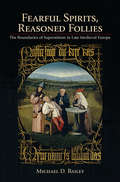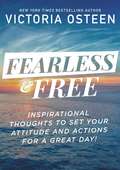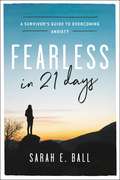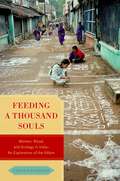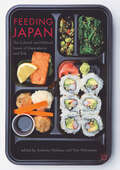- Table View
- List View
Fear and Trembling and The Sickness Unto Death
by Søren Kierkegaard Walter Lowrie Gordon MarinoWalter Lowrie's classic, bestselling translation of Søren Kierkegaard's most important and popular books remains unmatched for its readability and literary quality. Fear and Trembling and The Sickness Unto Death established Kierkegaard as the father of existentialism and have come to define his contribution to philosophy. Lowrie's translation, first published in 1941 and later revised, was the first in English, and it has introduced hundreds of thousands of readers to Kierkegaard's thought. Kierkegaard counted Fear and Trembling and The Sickness Unto Death among "the most perfect books I have written," and in them he introduces two terms--"the absurd" and "despair"--that have become key terms in modern thought. Fear and Trembling takes up the story of Abraham and Isaac to explore a faith that transcends the ethical, persists in the face of the absurd, and meets its reward in the return of all that the faithful one is willing to sacrifice, while The Sickness Unto Death examines the spiritual anxiety of despair. Walter Lowrie's magnificent translation of these seminal works continues to provide an ideal introduction to Kierkegaard. And, as Gordon Marino argues in a new introduction, these books are as relevant as ever in today's age of anxiety.
Fear and Trembling and The Sickness Unto Death
by Søren Kierkegaard Walter Lowrie Gordon MarinoWalter Lowrie's classic, bestselling translation of Søren Kierkegaard's most important and popular books remains unmatched for its readability and literary quality. Fear and Trembling and The Sickness Unto Death established Kierkegaard as the father of existentialism and have come to define his contribution to philosophy. Lowrie's translation, first published in 1941 and later revised, was the first in English, and it has introduced hundreds of thousands of readers to Kierkegaard's thought. Kierkegaard counted Fear and Trembling and The Sickness Unto Death among "the most perfect books I have written," and in them he introduces two terms--"the absurd" and "despair"--that have become key terms in modern thought. Fear and Trembling takes up the story of Abraham and Isaac to explore a faith that transcends the ethical, persists in the face of the absurd, and meets its reward in the return of all that the faithful one is willing to sacrifice, while The Sickness Unto Death examines the spiritual anxiety of despair. Walter Lowrie's magnificent translation of these seminal works continues to provide an ideal introduction to Kierkegaard. And, as Gordon Marino argues in a new introduction, these books are as relevant as ever in today's age of anxiety.
Fear No Evil: One Man Deals With Terminal Illness (Isis Large Print Ser.)
by David WatsonFacing the final test of faith, David Watson candidly shares his personal thoughts during his moving struggle with cancer: his doubts and fears but also his ability to trust in God and fear no evil.David Watson was an internationally renowned and much-loved preacher and writer. His many books include Discipleship, I Believe in the Church, Is Anyone There? and One in the Spirit. He died in 1984, a few weeks after writing the final pages of this book.'Fear No Evil is the conquest of death... by facing it squarely... and knowing that for a believer it is the vestibule of glory.' - J. I. Packer
The Fear of God in 2 Corinthians 7: Its Meaning, Function, and Eschatological Context (The Library of New Testament Studies)
by Euichang KimEuichang Kim focuses upon the phrase “the fear of God”, drawn from 2 Corinthians' exhortation to reconcile with God. As opposed to these words appearing from no particular source, Kim points to the wider contexts of Old Testament passages quoted by Paul, and demonstrates that God's eschatological promises – in particular his coming judgment, his promise to redeem his people, and the prospect of a new covenant – are intertwined with this motif of “fear”.Beginning with an analysis of the meaning of fear in both the Old Testament and the New, Kim proceeds to the context of fear within 2 Corinthians, Scripture, the writings of Second Temple Judaism and the very eschatology of Paul, suggesting that it stems from an awareness of God's judgment to come and serves to motivate righteous behavior. Kim finally argues that, in the context of 2 Corinthians, the “fear of God” functions as the proper response to God's saving acts in Christ, and provides motivation for believers to pursue a holy life in anticipation of the eschatological judgment to come.
The Fear of God in 2 Corinthians 7: Its Meaning, Function, and Eschatological Context (The Library of New Testament Studies)
by Euichang KimEuichang Kim focuses upon the phrase “the fear of God”, drawn from 2 Corinthians' exhortation to reconcile with God. As opposed to these words appearing from no particular source, Kim points to the wider contexts of Old Testament passages quoted by Paul, and demonstrates that God's eschatological promises – in particular his coming judgment, his promise to redeem his people, and the prospect of a new covenant – are intertwined with this motif of “fear”.Beginning with an analysis of the meaning of fear in both the Old Testament and the New, Kim proceeds to the context of fear within 2 Corinthians, Scripture, the writings of Second Temple Judaism and the very eschatology of Paul, suggesting that it stems from an awareness of God's judgment to come and serves to motivate righteous behavior. Kim finally argues that, in the context of 2 Corinthians, the “fear of God” functions as the proper response to God's saving acts in Christ, and provides motivation for believers to pursue a holy life in anticipation of the eschatological judgment to come.
The Fear Of Islam: An Introduction To Islamophobia In The West
by Todd GreenAmerican and European societies have struggled with the recurrent problem of Islamophobia, which continues to surface in waves of controversial legislative proposals, public anger over the construction of religious edifices, and outbreaks of violence. The ongoing conflict between Israel and Palestine contributes fuel to the aggressive debate in Western societies and creates the need for measured discussion about religion, fear, prejudice, otherness, and residual colonialist attitudes. The Fear of Islam speaks into this context, offering an introduction to the historical roots and contemporary forms of religious anxiety regarding Islam within the Western world. Tracing the medieval legacy of religious polemics and violence, Green weaves together a narrative that orients the reader to the complex history and issues that originate from this legacy, continuing through to the early and late modern colonial enterprises, the theories of "Orientalism," and the production of religious discourses of alterity and the clash of civilizations that proliferated in the era of 9/11 and the war on terror.
Fear of Muslims?: International Perspectives on Islamophobia (Boundaries of Religious Freedom: Regulating Religion in Diverse Societies #3)
by Douglas Pratt Rachel WoodlockThis book takes a sober, evidenced-based look at the contemporary phenomenon of Islamophobia in both ‘old-world’ Europe, and the ‘new-world’ of America and Australia, and Southeast Asia. It includes theoretical and conceptual discussions about what Islamophobia is, how it manifests, and how it can be addressed, together with historical analysis, applied research and case-study chapters, considering the reality that manifests as a fear of Muslims. Anxiety about the world’s second largest religion manifests as prejudice, discrimination and vilification and, in extreme cases, violence and murder. The real and perceived problems of the relationship between Islam and the West contribute to the phenomenon of Islamophobia. This is a unique, multi-disciplinary work, with authors approaching the topic from a number of academic disciplines and from different religious and national backgrounds, providing for a greater appreciation of the complexity and diversity of Islamophobia. This multicultural and multi-religious approach undergirds the valuable insights the volume provides. This book will be of interest to all concerned with the phenomenon of Islamophobia, and especially researchers and students in the social sciences, as well as scholars with a specific interest in Muslims living as minorities in the West. Also, those working in political science, international relations, sociology, religious studies and other fields will all find it of value.
The Fear of the Lord: Essays on Theological Method
by Michael AllenThis volume examines what it means to proceed in the path of wisdom by beginning with fear of God, that is, mindfulness always and everywhere of God's being and presence. Michael Allen describes the praxis of fearing the Lord, how that posture of contemplative pursuit marks the theological task and defines our theological method; in so doing it takes up the significant topics of divine revelation, theological exegesis, intellectual asceticism, and retrieval/ressourcement from a distinctly doctrinal perspective. In each of these conversations, doing theology in the presence of God functions as a consistent thread. God is not mere object but truly functions as subject in the process of theological growth, though God's presence and agency fund rather than negate creaturely theological responsibility.The Fear of the Lord: Essays on Theological Method explores some of the most central questions of contemporary theological method – revelation, Scripture, theological interpretation, retrieval, intellectual asceticism, scholastic method – by asking in each and every case what it means to think fundamentally of the perfect and present God involved and active in these spheres.
The Fear of the Lord: Essays on Theological Method
by Michael AllenThis volume examines what it means to proceed in the path of wisdom by beginning with fear of God, that is, mindfulness always and everywhere of God's being and presence. Michael Allen describes the praxis of fearing the Lord, how that posture of contemplative pursuit marks the theological task and defines our theological method; in so doing it takes up the significant topics of divine revelation, theological exegesis, intellectual asceticism, and retrieval/ressourcement from a distinctly doctrinal perspective. In each of these conversations, doing theology in the presence of God functions as a consistent thread. God is not mere object but truly functions as subject in the process of theological growth, though God's presence and agency fund rather than negate creaturely theological responsibility.The Fear of the Lord: Essays on Theological Method explores some of the most central questions of contemporary theological method – revelation, Scripture, theological interpretation, retrieval, intellectual asceticism, scholastic method – by asking in each and every case what it means to think fundamentally of the perfect and present God involved and active in these spheres.
Fearful Spirits, Reasoned Follies: The Boundaries of Superstition in Late Medieval Europe
by Michael D. BaileySuperstitions are commonplace in the modern world. Mostly, however, they evoke innocuous images of people reading their horoscopes or avoiding black cats. Certain religious practices might also come to mind—praying to St. Christopher or lighting candles for the dead. Benign as they might seem today, such practices were not always perceived that way. In medieval Europe superstitions were considered serious offenses, violations of essential precepts of Christian doctrine or immutable natural laws. But how and why did this come to be? In Fearful Spirits, Reasoned Follies, Michael D. Bailey explores the thorny concept of superstition as it was understood and debated in the Middle Ages. Bailey begins by tracing Christian thinking about superstition from the patristic period through the early and high Middle Ages. He then turns to the later Middle Ages, a period that witnessed an outpouring of writings devoted to superstition—tracts and treatises with titles such as De superstitionibus and Contra vitia superstitionum. Most were written by theologians and other academics based in Europe’s universities and courts, men who were increasingly anxious about the proliferation of suspect beliefs and practices, from elite ritual magic to common healing charms, from astrological divination to the observance of signs and omens. As Bailey shows, however, authorities were far more sophisticated in their reasoning than one might suspect, using accusations of superstition in a calculated way to control the boundaries of legitimate religion and acceptable science. This in turn would lay the conceptual groundwork for future discussions of religion, science, and magic in the early modern world. Indeed, by revealing the extent to which early modern thinkers took up old questions about the operation of natural properties and forces using the vocabulary of science rather than of belief, Bailey exposes the powerful but in many ways false dichotomy between the "superstitious" Middle Ages and "rational" European modernity.
Fearfully and Wonderfully: The marvel of bearing God's image
by Philip Yancey Dr Paul BrandMysterious, intricate, pulsing with energy ... the human body is an endlessly fascinating repository of incredible secrets. In this new work, comprising two classics (Fearfully and Wonderfully Made and In His Image) edited together and updated, renowned surgeon Dr Paul Brand and award-winning writer Philip Yancey take us on a tour of wonder through the human body.Illustrated with stories from Dr Brand's ground-breaking career as a hand surgeon who changed the lives of leprosy sufferers by transforming medical treatment protocols, this lively narrative paints an unforgettable portrait of the incredible unity of the human body in its trillions of parts.As compassionate as he was brilliant, Dr Brand cared as much about his suffering patients as he was intensely curious about how the body works. And so just as his brilliant intuition - which led to medical breakthroughs earning him international awards and acclaim - makes human physiology come alive on the page, so does his deep love for people in their dignity as image-bearers make spirituality come alive on the page as well.Although Brand and Yancey do not presume that readers share their Christian faith, they trace the metaphor of 'one body, many parts' from a medical perspective on human life as well as a mystical perspective on the unifying presence of the Body of Christ. Filled with riveting stories of Dr Brand's work among the marginalized and outcast, this journey of understanding offers astonishing insights and page-turning reading.
Fearless and Free: Inspirational Thoughts to Set Your Attitude and Actions for a Great Day!
by Victoria OsteenLive vibrantly, love openly, and embody kindness with daily devotions from New York Times bestselling author Victoria Osteen!Victoria Osteen wants you to start your day by daringly moving in the right direction. In this new and empowering devotional, Fearless and Free, you will find inspiration that will equip you to live boldly, courageously and fully confident in who God created you to be. Victoria provides you with new insights that will inspire you to anticipate good things and know that God has given you the strength for every battle. Live every day knowing you are fearless, free, and fully prepared for the life God meant for you to live.
Fearless and Free: Inspirational Thoughts to Set Your Attitude and Actions for a Great Day!
by Victoria OsteenLive confidently. Believe expectantly. Embrace your victory!In this new and empowering devotional from New York Times bestselling author Victoria Osteen, you will be inspired to live boldly and courageously each day. Victoria provides you with refreshing insights that will give you the strength and power to press on and live your life to the fullest. She will show you how minor adjustments in your everyday life bring about major victories. When you discover how these changes in your attitude and actions elevate your life, you will live Fearless and Free.
Fearless in 21 Days: A Survivor's Guide to Overcoming Anxiety
by Sarah E. Ballp.p1 {margin: 0.0px 0.0px 0.0px 0.0px; font: 11.0px Helvetica} p.p2 {margin: 0.0px 0.0px 0.0px 0.0px; font: 11.0px Helvetica; min-height: 13.0px} span.s1 {font-kerning: none} FEARLESS IN 21 DAYS is a testimony of hope and a day-by-day guide to healing the mind using mental, emotional, physical, and spiritual applications for those bound by crippling fear, anxiety, panic disorders, and depression. In the summer of 2013, family and friends watched helplessly as author Sarah E. Ball spiraled into the darkest season of her life. A passionate woman of God, wife, mom of five, and popular blogger, Sarah nevertheless found herself abruptly taken captive by a severe anxiety and panic disorder that left her bedridden for months. Those around her were shocked at her fast derailment because she had always been a very strong, dependable woman. With time and perseverance, her determination and faith in God led her out of anxiety and into a place of complete freedom. After Sarah found deliverance from mental illness she was determined to reach back into the pit and pull the next person out. She began sharing the intimate details of her breakdown and recovery with her readers, creating an online series Fearless in 21 Days as a daily guide to overcoming anxiety. After the series gained an increasing amount of attention, Sarah expanded the series into an award-winning full book manuscript.In FEARLESS IN 21 DAYS, Sarah takes the readers through 21 revelations that focus on healing the whole self-body, mind, and soul-and bridging the gap between effective mental health therapies and Scripture. The book begins with practical tips that can dramatically reduce the immediate symptoms of anxiety and then dives deeper into spiritual and mental truths to create a hope-filled guide to freedom from anxiety so that readers may boldly and bravely fulfill their purpose in Christ-fearlessly.
Fearless in 21 Days: A Survivor's Guide to Overcoming Anxiety
by Sarah E. BallFearless in 21 Days is a testimony of hope and a day-by-day guide to healing the mind using mental, emotional, physical, and spiritual applications for those bound by crippling fear, anxiety, panic disorders, and depression. In the summer of 2013, family and friends watched helplessly as author Sarah E. Ball spiraled into the darkest season of her life. A passionate woman of God, wife, mom of five, and popular blogger, Sarah nevertheless found herself abruptly taken captive by a severe anxiety and panic disorder that left her bedridden for months. Those around her were shocked at her fast derailment because she had always been a very strong, dependable woman. With time and perseverance, her determination and faith in God led her out of anxiety and into a place of complete freedom. After Sarah found deliverance from mental illness she was determined to reach back into the pit and pull the next person out. She began sharing the intimate details of her breakdown and recovery with her readers, creating an online series Fearless in 21 Days as a daily guide to overcoming anxiety. After the series gained an increasing amount of attention, Sarah expanded the series into an award-winning full book manuscript.In Fearless in 21 Days, Sarah takes the readers through 21 revelations that focus on healing the whole self-body, mind, and soul-and bridging the gap between effective mental health therapies and Scripture. The book begins with practical tips that can dramatically reduce the immediate symptoms of anxiety and then dives deeper into spiritual and mental truths to create a hope-filled guide to freedom from anxiety so that readers may boldly and bravely fulfill their purpose in Christ-fearlessly.
Federico Barocci: Inspiration and Innovation in Early Modern Italy (Visual Culture in Early Modernity)
by Judith W. MannReviewers of a recent exhibition termed Federico Barocci (ca. 1533–1612), 'the greatest artist you’ve never heard of'. One of the first original iconographers of the Counter Reformation, Barocci was a remarkably inventive religious painter and draftsman, and the first Italian artist to incorporate extensive color into his drawings. The purpose of this volume is to offer new insights into Barocci’s work and to accord this artist, the dates of whose career fall between the traditional Renaissance and Baroque periods, the critical attention he deserves. Employing a range of methodologies, the essays include new ideas on Barocci’s masterpiece, the Entombment of Christ; fresh thinking about his use of color in his drawings and innovative design methods; insights into his approach to the nude; revelations on a key early patron; a consideration of the reasons behind some of his most original iconography; an analysis of his unusual approach to the marketing of his pictures; an exploration of some little-known aspects of his early production, such as his reliance on Italian majolica and contemporary sculpture in developing his compositions; and an examination of a key Barocci document, the post mortem inventory of his studio. A translated transcription of the inventory is included as an appendix.
Federico Barocci: Inspiration and Innovation in Early Modern Italy (Visual Culture in Early Modernity)
by Judith W. MannReviewers of a recent exhibition termed Federico Barocci (ca. 1533–1612), 'the greatest artist you’ve never heard of'. One of the first original iconographers of the Counter Reformation, Barocci was a remarkably inventive religious painter and draftsman, and the first Italian artist to incorporate extensive color into his drawings. The purpose of this volume is to offer new insights into Barocci’s work and to accord this artist, the dates of whose career fall between the traditional Renaissance and Baroque periods, the critical attention he deserves. Employing a range of methodologies, the essays include new ideas on Barocci’s masterpiece, the Entombment of Christ; fresh thinking about his use of color in his drawings and innovative design methods; insights into his approach to the nude; revelations on a key early patron; a consideration of the reasons behind some of his most original iconography; an analysis of his unusual approach to the marketing of his pictures; an exploration of some little-known aspects of his early production, such as his reliance on Italian majolica and contemporary sculpture in developing his compositions; and an examination of a key Barocci document, the post mortem inventory of his studio. A translated transcription of the inventory is included as an appendix.
Feeding a Thousand Souls: Women, Ritual, and Ecology in India- An Exploration of the Kolam
by Vijaya NagarajanEvery day millions of Tamil women in southeast India wake up before dawn to create a kolam, an ephemeral ritual design made with rice flour, on the thresholds of homes, businesses and temples. This thousand-year-old ritual welcomes and honors Lakshmi, the goddess of wealth and alertness, and Bhudevi, the goddess of the earth. Created by hand with great skill, artistry, and mathematical precision, the kolam disappears in a few hours, borne away by passing footsteps and hungry insects. This is the first comprehensive study of the kolam in the English language. It examines its significance in historical, mathematical, ecological, anthropological, and literary contexts. The culmination of Vijaya Nagarajan's many years of research and writing on this exacting ritual practice, Feeding a Thousand Souls celebrates the experiences, thoughts, and voices of the Tamil women who keep this tradition alive.
Feeding a Thousand Souls: Women, Ritual, and Ecology in India- An Exploration of the Kolam
by Vijaya NagarajanEvery day millions of Tamil women in southeast India wake up before dawn to create a kolam, an ephemeral ritual design made with rice flour, on the thresholds of homes, businesses and temples. This thousand-year-old ritual welcomes and honors Lakshmi, the goddess of wealth and alertness, and Bhudevi, the goddess of the earth. Created by hand with great skill, artistry, and mathematical precision, the kolam disappears in a few hours, borne away by passing footsteps and hungry insects. This is the first comprehensive study of the kolam in the English language. It examines its significance in historical, mathematical, ecological, anthropological, and literary contexts. The culmination of Vijaya Nagarajan's many years of research and writing on this exacting ritual practice, Feeding a Thousand Souls celebrates the experiences, thoughts, and voices of the Tamil women who keep this tradition alive.
Feeding Japan: The Cultural and Political Issues of Dependency and Risk
by Andreas Niehaus and Tine WalravensThis edited collection explores the historical dimensions, cultural practices, socio-economic mechanisms and political agendas that shape the notion of a national cuisine inside and outside of Japan. Japanese food is often perceived as pure, natural, healthy and timeless, and these words not only fuel a hype surrounding Japanese food and lifestyle worldwide, but also a domestic retro-movement that finds health and authenticity in ‘traditional’ ingredients, dishes and foodways. The authors in this volume bring together research from the fields of history, cultural and religious studies, food studies as well as political science and international relations, and aim to shed light on relevant aspects of culinary nationalism in Japan while unearthing the underlying patterns and processes in the construction of food identities.
Feeding the Eternal City: Jewish and Christian Butchers in the Roman Ghetto (I Tatti Studies in Italian Renaissance History)
by Kenneth StowA surprising history of interfaith collaboration in the Roman Ghetto, where for three centuries Jewish and Christian butchers worked together to provision the city despite the proscriptions of Church law.For Rome’s Jewish population, confined to a ghetto between 1555 and 1870, efforts to secure kosher meat were fraught with challenges. The city’s papal authorities viewed kashrut—the Jewish dietary laws—with suspicion, and it was widely believed that kosher meat would contaminate any Christian who consumed it. Supplying kosher provisions entailed circumventing canon law and the institutions that regulated the butchering and sale of meat throughout the city.Kenneth Stow finds that Jewish butchers collaborated extensively with their Christian counterparts to ensure a supply of kosher meat, regardless of the laws that prohibited such interactions. Jewish butchers sold nonkosher portions of slaughtered animals daily to Christians outside the ghetto, which in turn ensured the affordability of kosher meat. At the same time, Christian butchers also found it profitable to work with Jews, as this enabled them to sell good meat otherwise unavailable at attractive prices. These relationships could be warm and almost intimate, but they could also be rife with anger, deception, and even litigation. Nonetheless, without this close cooperation—and the willingness of authorities to turn a blind eye to it—meat-eating in the ghetto would have been nearly impossible. Only the rise of the secular state in the late nineteenth century brought fundamental change, putting an end to canon law and allowing the kosher meat market to flourish.A rich social history of food in early modern Rome, Feeding the Eternal City is also a compelling narrative of Jewish life and religious acculturation in the capital of Catholicism.
The Feeling Buddha: An Introduction to Buddhism
by David BrazierThis account explains how the Buddha's path of wisdom and loving kindness grew out of the challenges he encountered in life. It explores enlightenment, nirvana, and the Four Noble Truths, presenting a picture of the Buddha as a very human figure whose success lay not in his perfection, but in his method of positively utilizing the energy generated by personal suffering.
Feeling Like Saints: Lollard Writings after Wyclif
by Fiona Somerset"Lollard" is the name given to followers of John Wyclif, the English dissident theologian who was dismissed from Oxford University in 1381 for his arguments regarding the eucharist. A forceful and influential critic of the ecclesiastical status quo in the late fourteenth century, Wyclif’s thought was condemned at the Council of Constance in 1415. While lollardy has attracted much attention in recent years, much of what we think we know about this English religious movement is based on records of heresy trials and anti-lollard chroniclers. In Feeling Like Saints, Fiona Somerset demonstrates that this approach has limitations. A better basis is the five hundred or so manuscript books from the period (1375–1530) containing materials translated, composed, or adapted by lollard writers themselves. These writings provide rich evidence for how lollard writers collaborated with one another and with their readers to produce a distinctive religious identity based around structures of feeling. Lollards wanted to feel like saints. From Wyclif they drew an extraordinarily rigorous ethic of mutual responsibility that disregarded both social status and personal risk. They recalled their commitment to this ethic by reading narratives of physical suffering and vindication, metaphorically martyring themselves by inviting scorn for their zeal, and enclosing themselves in the virtues rather than the religious cloister. Yet in many ways they were not that different from their contemporaries, especially those with similar impulses to exceptional holiness.
The Feeling of Forgetting: Christianity, Race, and Violence in America
by John CorriganA provocative examination of how religious practices of forgetting drive white Christian nationalism. The dual traumas of colonialism and slavery are still felt by Native Americans and African Americans as victims of ongoing violence toward people of color today. In The Feeling of Forgetting, John Corrigan calls attention to the trauma experienced by white Americans as perpetrators of this violence. By tracing memory’s role in American Christianity, Corrigan shows how contemporary white Christian nationalism is motivated by a widespread effort to forget the role race plays in American society. White trauma, Corrigan argues, courses through American culture like an underground river that sometimes bursts forth into brutality, terrorism, and insurrection. Tracing the river to its source is a necessary first step toward healing.
The Feeling of History: Islam, Romanticism, and Andalusia
by Charles HirschkindIn today’s world, the lines between Europe and the Middle East, between Christian Europeans and Muslim immigrants in their midst, seem to be hardening. Alarmist editorials compare the arrival of Muslim refugees with the “Muslim conquest of 711,” warning that Europe will be called on to defend its borders. Violence and paranoia are alive and well in Fortress Europe. Against this xenophobic tendency, The Feeling of History examines the idea of Andalucismo—a modern tradition founded on the principle that contemporary Andalusia is connected in vitally important ways with medieval Islamic Iberia. Charles Hirschkind explores the works and lives of writers, thinkers, poets, artists, and activists, and he shows how, taken together, they constitute an Andalusian sensorium. Hirschkind also carefully traces the various itineraries of Andalucismo, from colonial and anticolonial efforts to contemporary movements supporting immigrant rights. The Feeling of History offers a nuanced view into the way people experience their own past, while also bearing witness to a philosophy of engaging the Middle East that experiments with alternative futures.







